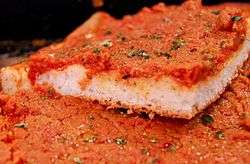Pizza al taglio
 | |
| Alternative names | Pizza al trancio |
|---|---|
| Type | Pizza |
| Place of origin | Rome, Italy |
| Main ingredients | Pizza dough, sauce, cheese, toppings |
|
| |
| Part of a series on |
| Pizza |
|---|
.jpg) |
|
Pizza varieties
|
|
Cooking variations |
|
Pizza tools |
|
Related articles |
Pizza al taglio or pizza al trancio (Italian for pizza by the slice — literally "by the cut")[1] is a variety of pizza baked in large rectangular trays,[2] and generally sold in rectangular or square slices by weight, with prices marked per kilogram or per 100 grams.[3] This type of pizza was invented in Rome, Italy, and is common throughout Italy.[4] Many variations and styles of pizza al taglio exist, and the dish is available in other areas of the world in addition to Italy.
Preparation
In the most traditional Italian pizza al taglio 'parlours' or outlets, such as pizzerie and bakeries, the pizza is often cooked in a wood-fired oven.[4] In today's establishments, electric ovens are also often used. The concept is similar to fast food. The main emphasis may not be upon the visual aspect of the pizza. Rather, the taste of the product and convenience of the process may be a priority. The rectangular pizza shape[4] makes it easier to cut and divide the pizza to the buyer's desire, which is often distinguished by weight.[5]
Varieties
The simplest varieties include pizza Margherita (tomato sauce and cheese), pizza bianca (olive oil, rosemary and garlic),[4] and pizza rossa (tomato sauce only). Other typical toppings include artichokes, asparagus, eggplant, ground meat and onions, potatoes, prosciutto, salami, sausage, ground truffles, zucchini, olive oil sun-dried tomatoes, rocket, gorgonzola, anchovies, and black olives.
By region

Pizza al taglio was invented in Rome, Italy.[4] It's a popular casual food in Italy,[6] Argentina and Malta, where for many years it has been a common way for people to grab a quick snack or meal. The dish is often eaten as a takeaway dish that is eaten outside of restaurants where it is served,[3] such as in a piazza.[4] It has started to catch on in many other countries with differences in the styles of crusts, and toppings, suiting their own cultures.
See also
-
 Food portal
Food portal
References
- ↑ Garwood, Duncan; Hole, Abigail (2008). Lonely Planet Rome: City Guide. Lonely Planet. p. 185. ISBN 1741046599. Retrieved November 2012. Check date values in:
|access-date=(help) - ↑ Giudice, Teresa; MacLean, Heather (2011). Fabulicious! Teresa's Italian Family Cookbook. Running Press. p. 148. ISBN 0762442395. Retrieved November 2012. Check date values in:
|access-date=(help) - 1 2 Buckley, Jonathan; Ellingham, Mark (2009). The Rough Guide to Tuscany & Umbria. Penguin. p. 36. ISBN 1405385294. Retrieved November 2012. Check date values in:
|access-date=(help) - 1 2 3 4 5 6 Braimbridge; (et al.), Sophie (2003). A Little Taste Of...Italy. Murdoch Books. p. 16. ISBN 086411947X. Retrieved November 2012. Check date values in:
|access-date=(help) - ↑ Parasecoli, Fabio (2004). Food Culture In Italy. Greenwood Publishing Group. p. 151. ISBN 0313327262. Retrieved November 2012. Check date values in:
|access-date=(help) - ↑ Fodors (2011). Fodor's Italy 2011. Random House Digital, Inc. p. 931. ISBN 0307928527. Retrieved November 2012. Check date values in:
|access-date=(help)
